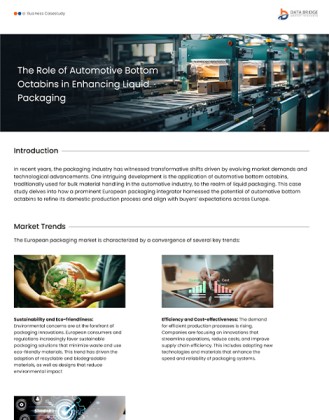Introduction
In recent years, the packaging industry has witnessed transformative shifts driven by evolving market demands and technological advancements. One intriguing development is the application of automotive bottom octabins, traditionally used for bulk material handling in the automotive industry, to the realm of liquid packaging. This case study delves into how a prominent European packaging integrator harnessed the potential of automotive bottom octabins to refine its domestic production process and align with buyers’ expectations across Europe.
Market Trends
The European packaging market is characterized by a convergence of several key trends:
- Sustainability and Eco-friendliness: Environmental concerns are at the forefront of packaging innovations. European consumers and regulations increasingly favor sustainable packaging solutions that minimize waste and use eco-friendly materials. This trend has driven the adoption of recyclable and biodegradable materials, as well as designs that reduce environmental impact
- Efficiency and Cost-effectiveness: The demand for efficient production processes is rising. Companies are focusing on innovations that streamline operations, reduce costs, and improve supply chain efficiency. This includes adopting new technologies and materials that enhance the speed and reliability of packaging systems.
- Customization and Versatility: There is a growing need for packaging solutions that cater to specific product requirements. Liquid packaging, in particular, requires designs that can accommodate various liquid types, from beverages to industrial chemicals, while ensuring product integrity and ease of use.
Automotive bottom octabins, known for their sturdy construction and efficient space utilization in bulk material handling, present an opportunity to address these trends in the liquid packaging sector. Their design, initially tailored for the automotive industry, offers potential benefits in terms of strength, stackability, and handling efficiency.
Client Challenges
The client, a leading European packaging integrator, faced several challenges in integrating automotive bottom octabins into their liquid packaging operations:
- Adapting to Industry Standards: The transition from automotive to packaging applications required modifications to ensure that the octabins met the stringent standards of the liquid packaging industry. This involved reengineering the design to accommodate liquid products while maintaining durability and safety
- Cost Management: Balancing the cost of implementing new packaging solutions with maintaining profitability was a critical concern. The client needed to ensure that the new design would be cost-effective both in terms of production and in its impact on the overall supply chain
- Market Acceptance: Ensuring that European buyers would accept the redesigned packaging was crucial. The packaging needed to meet buyers’ expectations regarding performance, sustainability, and aesthetic appeal
DBMR Approach and Resolution
Data Bridge Market Research (DBMR) was engaged to address these challenges through a structured approach:
- Market Analysis: DBMR commenced with an in-depth analysis of current market trends and consumer preferences. This included a review of the packaging industry’s move towards sustainability and efficiency, as well as the specific needs of liquid packaging. By understanding these trends, DBMR could tailor the automotive bottom octabin solution to align with market demands
- Feasibility Study: A comprehensive feasibility study was conducted to evaluate how automotive bottom octabins could be adapted for liquid packaging. This involved assessing material compatibility, structural modifications, and potential cost implications. The study focused on ensuring that the octabins could safely and effectively contain various types of liquids without compromising on quality or performance
- Prototype Development: Based on the findings from the feasibility study, DBMR facilitated the development of prototypes. These prototypes were engineered to address the specific requirements of liquid packaging. This phase included testing for factors such as leak prevention, strength, and compatibility with filling and handling equipment
- Buyer Feedback: To ensure the new packaging met market expectations, DBMR organized focus groups and feedback sessions with key European buyers. This direct feedback was invaluable in refining the prototypes and addressing any concerns regarding performance, sustainability, and design
- Implementation Plan: DBMR developed a detailed implementation plan for scaling up production. This included recommendations for sourcing materials, adjusting manufacturing processes, and training staff. The plan was designed to ensure a smooth transition from prototype to full-scale production, minimizing disruptions and optimizing efficiency
Business Impact
The integration of automotive bottom octabins into the client’s liquid packaging operations yielded significant benefits:
- Enhanced Efficiency: The new packaging design streamlined the production process. The robust and stackable nature of the automotive bottom octabins facilitated easier handling and storage, reducing the time and labor required for packaging operations. This efficiency gain translated into lower operational costs and improved throughput
- Sustainability Improvements: The redesigned packaging solution aligned with European sustainability goals. The use of automotive bottom octabins contributed to reducing the environmental footprint of packaging operations. The materials and design were selected to be more environmentally friendly, helping the client meet regulatory requirements and appeal to eco-conscious consumers
- Market Acceptance: The feedback from European buyers was overwhelmingly positive. The new packaging design met the performance and sustainability criteria that buyers sought, leading to increased market acceptance and a stronger competitive position. The client successfully differentiated itself in the market by offering an innovative and eco-friendly packaging solution
- Cost Savings: Implementing the automotive bottom octabins resulted in significant cost savings. The improved efficiency of the packaging process reduced material wastage and labor costs. Additionally, the long-term durability of the octabins contributed to lower overall packaging costs
Conclusion
By leveraging DBMR’s insights and expertise, the European packaging integrator was able to navigate the challenges of adapting a novel solution to meet industry standards and market demands.
The successful implementation of automotive bottom octabins enhanced the efficiency and sustainability of the client’s packaging operations and also ensured alignment with European buyers’ expectations. This case study highlights the value of innovative thinking and market research in achieving business objectives and staying ahead in a competitive industry. The positive outcomes underscore the potential for similar cross-industry applications to drive advancements and deliver tangible benefits in various sectors.


